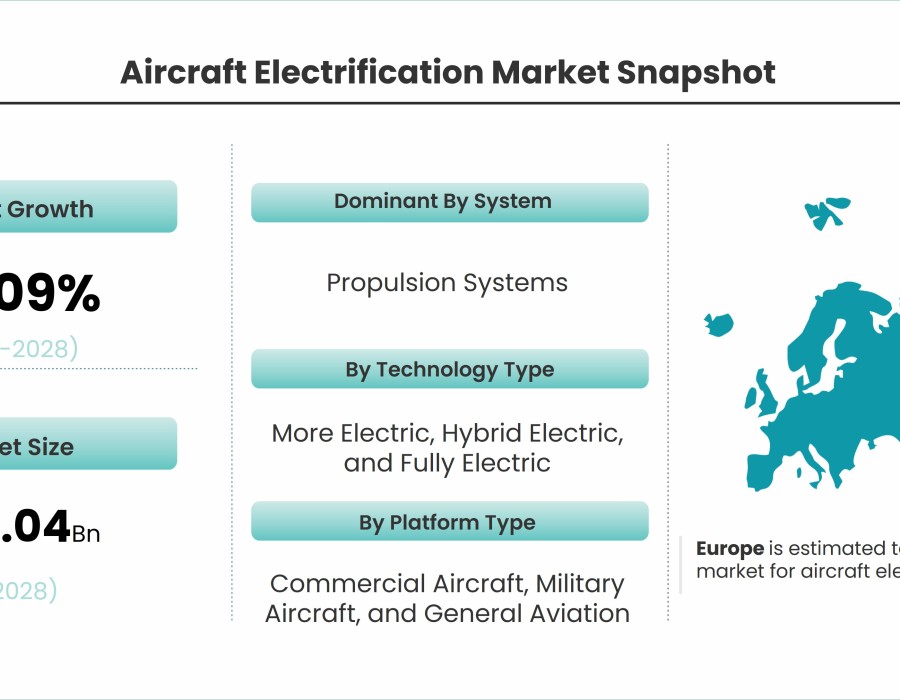The aircraft electrification industry is witnessing rapid growth as the aviation sector embraces cleaner, more efficient technologies to meet environmental and regulatory demands. This shift toward electrification presents a range of exciting opportunities, both for established aerospace companies and new market entrants, as they work to revolutionize air travel. Here’s an in-depth look at the market opportunities driving the electrification of aviation and shaping the future of this emerging industry.
According to Stratview Research, the aircraft electrification market was estimated at USD 6.8 billion in 2022 and is likely to grow at a CAGR of 14.09% during 2023-2028 to reach USD 15.04 billion in 2028.
1. Decarbonizing Aviation
One of the most significant opportunities in the aircraft electrification industry is the potential to reduce aviation’s carbon footprint. The sector accounts for a sizable percentage of global greenhouse gas emissions, and as climate change becomes an increasingly urgent issue, there is mounting pressure to develop sustainable solutions. Electrified aircraft, including hybrid-electric and fully electric models, offer a promising path forward. By adopting electric propulsion systems, the industry can decrease its dependence on fossil fuels and move closer to achieving net-zero emissions targets. This creates opportunities for innovation in green technologies, energy storage systems, and efficient aircraft designs.
2. Advancements in Battery Technology
A key driver of growth in the aircraft electrification market is the rapid advancement of battery technology. Historically, one of the major challenges in electrifying aviation has been the limitations of battery energy density. However, recent breakthroughs in lithium-ion batteries, solid-state batteries, and other energy storage systems are making electric propulsion more viable for a range of aircraft, from small commuter planes to larger regional jets. Companies that specialize in battery development and energy management systems are well-positioned to capitalize on the growing demand for higher-performance, lightweight batteries tailored to aviation needs.
3. Emergence of Urban Air Mobility (UAM)
The rise of urban air mobility (UAM) is another exciting area of opportunity within the aircraft electrification industry. With growing interest in air taxis, drones, and short-haul electric flights, UAM represents a new frontier in transportation. Electric vertical take-off and landing (eVTOL) aircraft, designed for urban environments, are gaining traction as a sustainable and efficient alternative to ground-based transportation. This sector is expected to grow rapidly in the coming years, opening opportunities for manufacturers, technology developers, and infrastructure providers.
4. Investment in Infrastructure
As electrification of aircraft becomes more widespread, there is an increasing need for the supporting infrastructure to facilitate electric air travel. Charging stations at airports, energy distribution networks, and maintenance facilities tailored to electric aircraft are crucial for the growth of this industry. This infrastructure development presents significant opportunities for companies involved in construction, energy management, and airport modernization. Governments and private investors are recognizing this need, leading to increased funding for infrastructure projects that support electric aviation.
Conclusion
The aircraft electrification industry is brimming with opportunities as the demand for sustainable aviation solutions continues to rise. From reducing carbon emissions to advancing battery technology and developing urban air mobility solutions, electrification offers a transformative future for aviation. Companies that seize these opportunities and invest in innovative technologies and infrastructure will be well-positioned to thrive in this rapidly growing industry, helping to shape the future of air travel for decades to come.






Comments